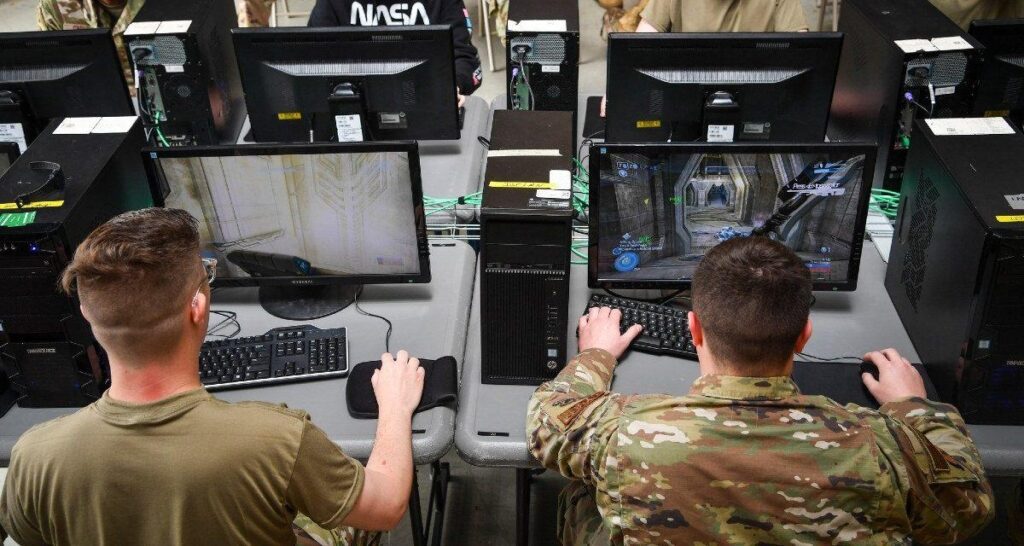This article explores the evolution of military wargaming simulations, from their origins on the battlefield to their transformation into immersive virtual experiences. Wargaming has a long history, dating back to the early 19th century when it was recognized as a valuable training tool for officers. The concept then transitioned to board games, allowing players to simulate war on a larger scale. With the advent of computers, wargaming simulations became more advanced, incorporating improved graphics and realism. The introduction of virtual reality technology took wargaming to a whole new level, allowing players to physically immerse themselves in realistic combat scenarios. These advancements have not only enhanced the gaming experience but also revolutionized military training.
From the Battlefield to the Screen: The Evolution of Military Wargaming Simulations
Introduction
In recent years, military wargaming simulations have become increasingly popular, both as a source of entertainment for gamers and as a training tool for the military. This article explores the evolution of military wargaming simulations, from their origins on the battlefield to their transformation into immersive virtual experiences.
The Birth of Wargaming
Wargaming itself has a long history, stretching back centuries. The concept of simulating military scenarios for strategic planning purposes dates back to the early 19th century. Prussian military officer and theorist Carl von Clausewitz recognized the importance of understanding the dynamics of wars and proposed the use of wargames to train officers. These early wargames were played with miniature models and cardboard cutouts, allowing officers to visualize battles and test various strategies.
From Board Games to Computer Simulations
As technology advanced, wargaming simulations made their way to the tabletop, with board games like Risk and Axis & Allies becoming popular in the mid-20th century. These games allowed players to simulate war on a larger scale, strategizing and making decisions that would impact the outcome of the game.
However, it was the advent of computers that truly revolutionized military wargaming simulations. In the 1980s, with the rise of personal computers, developers began creating computerized versions of wargames. These early computer simulations allowed players to control digital armies and experiment with different tactics. While still limited in terms of graphics and user interface, these early wargaming simulations laid the groundwork for future advancements.
Advancements in Graphics and Realism
In the 1990s and early 2000s, with the introduction of more powerful hardware and improved graphics capabilities, military wargaming simulations took a significant leap forward. Developers began incorporating more realistic graphics, allowing players to immerse themselves in highly detailed virtual battlefields.
Alongside improved graphics, developers also focused on enhancing the realism of the simulations. Artificial intelligence was implemented to create more challenging opponents, and advanced physics engines added an extra layer of authenticity to the gameplay experience. These advancements brought military wargaming simulations closer to the real-world battlefield, making them invaluable training tools for military personnel.
The Rise of Virtual Reality
Today, military wargaming simulations have reached a new frontier with the introduction of virtual reality (VR) technology. VR takes immersion to a whole new level, allowing players to step into a virtual world and experience the intensity of battle in a highly realistic manner. With VR headsets and haptic feedback systems, players can physically move around and interact with their surroundings, creating a sense of presence that was previously unimaginable.
The introduction of VR has not only transformed the gaming experience but also revolutionized military training. Soldiers can now engage in realistic virtual combat scenarios, allowing them to practice and refine their skills in a safe and controlled environment. VR has become an essential tool for military training, providing soldiers with invaluable experience and minimizing the risks associated with live exercises.
Conclusion
From the humble beginnings of tabletop wargaming to the immersive virtual reality experiences of today, military wargaming simulations have come a long way. These simulations have evolved and adapted with advancements in technology, providing both gamers and the military with increasingly realistic and engaging experiences. As technology continues to advance, it is exciting to consider what the future holds for military wargaming simulations and how they will continue to shape the way we train, strategize, and understand the complexities of warfare.
